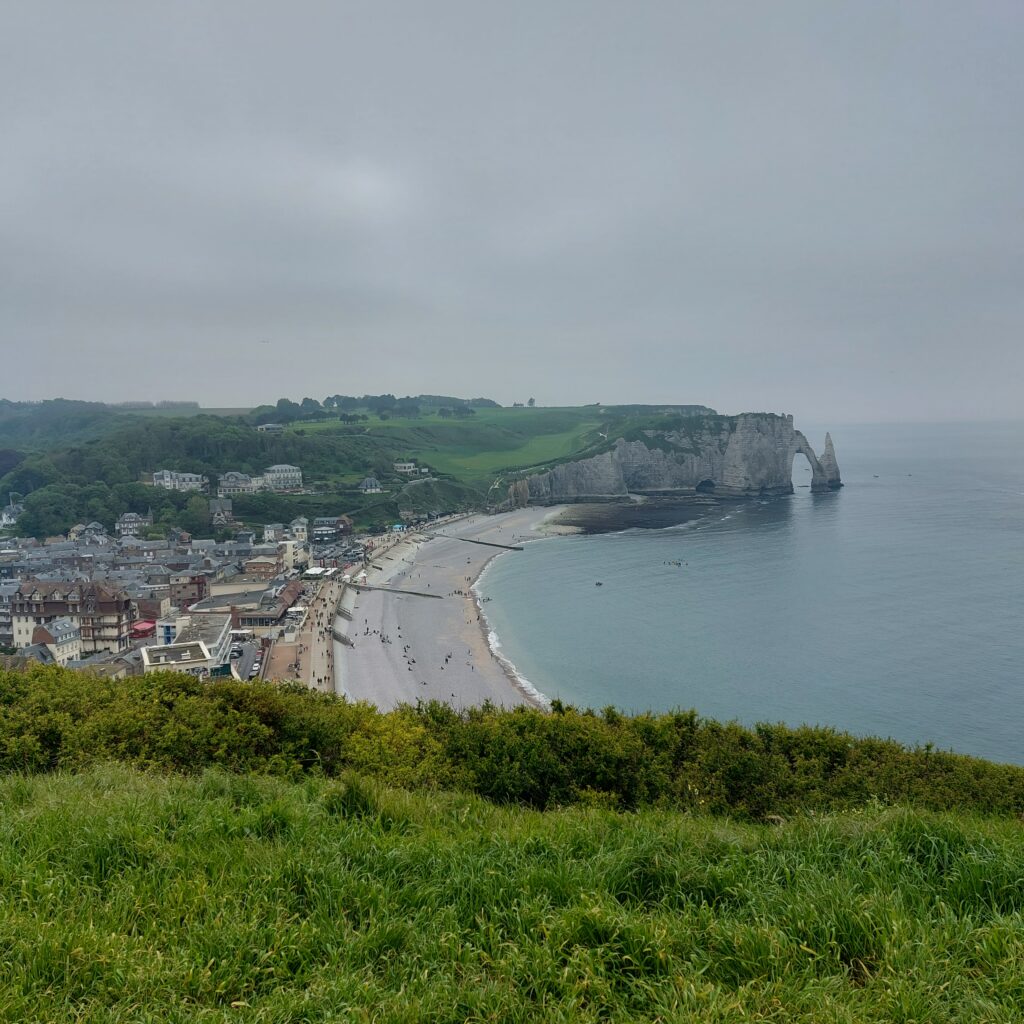The origin of the name Étretat has been widely studied and debated. From ancient times, people have tried to find explanations from Celtic and Latin/Old French, but without complete success. Later derivations from Norse have emerged as more plausible, including Torstad, Stútrstakkr (upright, high rock) and Styrrstaðr = ‘helmsman’s town’. But one thing is certain, the Vikings were here!

This village north of Le Havre is famous for the three arches that lie in a row by the English Channel. Farthest north (to the right when looking towards the sea) is the Porte d’Amont (Upstream Gate).

To the left of the beach you can see the beautiful Porte d’Aval (Downstream Gate) with a broken arch, l’Aiguille (The Needle) next to it, and further south and invisible from the city: Manneporte (big enough for a sailing ship with all sails up).

The light color of the cliffs has given the area it’s name ‘The Alabast Coast‘ = ‘The bright coast‘ (ref ‘The White cliffs of Dover‘ on the opposite side of the channel). Parallel to the coast, at Étretat, an underground river flows into the sea, and the arches have been eroded by this river. In older photos, women can be seen washing clothes on the beach at low tide (in fresh water). The beautiful arches are thus created by continental erosion and not by the sea. The limestone contains, among other things, flint, which is left behind as pebbles on the beach when the limestone is dissolved.

The place’s existence is linked to the sea, and in the 18th century oysters were grown and processed here. Baskets of shells were transported to Versailles overnight so that Marie-Antoinette could enjoy fresh oysters in the morning.

In the 19th century, tourists began to flock the site, and by the end of the 20th century, fishing was completely replaced by tourism as a means of living. No wonder, this place is stunning! So beautiful, that the place is used a lot both in literature and paintings. The creator of Arsène Lupin, Maurice Leblanc, lived in the area and his home is now a museum (Le Clos Arsène Lupin, Maison Maurice Leblanc). The last episode of the Netflix series Lupin was filmed in Étretat. But perhaps most famous are Claude Monet’s paintings of the beach and the arches.

The pebble beach at Étretat is somewhat demanding as a bathing spot. It is actually very good exercise to wade in pebbles on a steep beach. For us, a reminiscent of the movie ‘Rocky‘, who exercised hard by running in the snow. One step forward and half a step back… But it will be good for you (it was for us), and the water is clear and fresh, so beach life by Étretat is highly recommended.

At Porte d’Amont, there were no prohibiting signs against swimming, only for walking too close to the cliffs. Into the water we went. Currents? Oh yes! The tide was coming in, and when we lifted the legs up from the bottom we were pulled away northwards. The water level here changes 10-15 meter according to the tides… Terrifying, at least without an accompanying boat! Tobatheornottobathe didn’t swim under one single arch, but remained with ground contact…